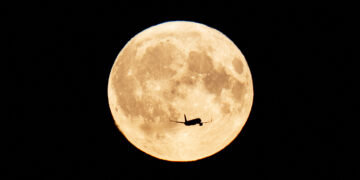2025 promises to be an extraordinary year for skywatchers, featuring a full moon every month, a total lunar eclipse, and a rare sequence of three consecutive supermoons. These celestial events not only provide stunning spectacles but also offer a deeper connection to both the natural world and human culture. Let’s explore what makes this year’s lunar calendar so special and why these events are worth marking on your calendar.
A Full Moon Every Month
The moon will grace the night sky in its full glory every month in 2025, with dates spanning January 13 to December 4. Full moons have fascinated humanity for centuries, influencing folklore, agriculture, and even human behavior. Each month’s full moon carries a traditional name steeped in cultural and historical significance.
January: The Wolf Moon
The year begins with the Wolf Moon on January 13. Historically, this name originates from the howling of wolves during winter. It symbolizes resilience and survival in harsh conditions. Observers in places like Rochester can catch this moon rising around 4:33 p.m., a golden opportunity for photographers and stargazers alike.
February: The Snow Moon
February’s Snow Moon on February 12 reflects the heavy snowfall typical of this month. Named by Native American tribes, it reminds us of winter’s grip and the anticipation of spring. Moonrise in Westchester, for instance, will occur at approximately 5:39 p.m., making it an evening spectacle.
March: The Worm Moon
The Worm Moon on March 14 coincides with the thawing ground and the reappearance of earthworms, heralding the arrival of spring. This particular full moon is unique in 2025, aligning with a total lunar eclipse.
The Total Lunar Eclipse
A total lunar eclipse, also known as a “blood moon,” occurs when the Earth casts its shadow fully over the moon, imparting an eerie red hue. In 2025, this celestial phenomenon will happen on March 14, lasting from 11:57 p.m. to 6:00 a.m. for New Yorkers.
The Science Behind the Blood Moon
The reddish glow of a blood moon is due to Rayleigh scattering—the same phenomenon that makes sunsets red. As sunlight passes through Earth’s atmosphere, shorter wavelengths (blue and violet) scatter, while longer wavelengths (red) bend toward the moon.
Why This Eclipse Matters
Total lunar eclipses are rare and offer valuable opportunities for scientists to study Earth’s atmosphere and the moon’s surface. For observers, this event serves as a reminder of the intricate dance between celestial bodies that governs our universe.
The Magic of Supermoons
Supermoons, occurring when the moon is closest to Earth in its orbit, will dominate the latter part of 2025. Mark your calendars for October 7, November 5, and December 4 for this extraordinary trilogy.
Why Are Supermoons Special?
Though the size difference may appear subtle, supermoons are up to 14% larger and 30% brighter than the faintest full moons of the year. These moons often inspire awe and have been linked to cultural myths about heightened emotions and natural phenomena.
Effects on Earth
Supermoons exert a stronger gravitational pull, leading to higher tides. For coastal areas, this effect can be both a beautiful and challenging phenomenon, showcasing the moon’s influence on our planet.
Moonrise and Moonset: Practical Tips
Knowing when and where to look enhances the lunar experience. The Old Farmer’s Almanac offers accurate moonrise and moonset times based on your location. For instance:
- The Wolf Moon in Rochester will rise at 4:33 p.m. on January 13.
- The Snow Moon in Westchester will rise at 5:39 p.m. on February 12.
The Cultural Significance of Lunar Names
The names of full moons are rooted in traditions from Native American tribes, colonial settlers, and other cultures. These names reflect seasonal changes, agricultural cycles, and even animal behavior.
Examples of Lunar Traditions
- April’s Pink Moon: Named for the bloom of wild ground phlox, a harbinger of spring.
- November’s Beaver Moon: Historically marked the time to set beaver traps before winter.
Conclusion
The lunar calendar for 2025 is a gift to skywatchers and science enthusiasts alike. From the monthly full moons to the rare alignment of a total lunar eclipse and consecutive supermoons, this year offers a celestial showcase that’s not to be missed.



















